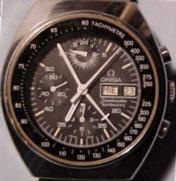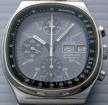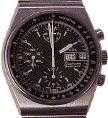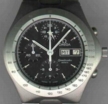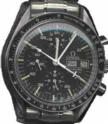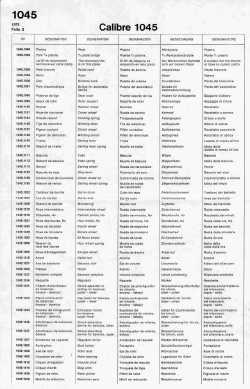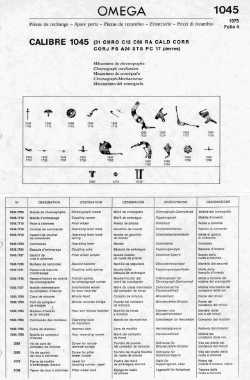-
Foreward:
All of this started back on
on 18 December 1999 when Jay Levy posted the following
query:
-
- I have just acquired
an Omega Speedmaster, but no one including the seller
could tell me much about it. Here is the
description:
- Omega Speedmaster
Automatic
- Day & Date
windows at 3:00
- 24 hour dial at
12:00
- Sweep second dial at
9:00
- Chrono second &
minute hands rotate from center of dial, as do regular
hour & minute hands.
- Dial at 6:00 is for
chron hours (I guess)
- One other thing - the
entire case can be pushed down out of the
bracelet.
- The back has the
Seamonster logo and the word
"Seamaster".
- I can send a scan if
you e-mail me. I would like to know anything about
this watch - model number, age, value,
-
- Thanks in advance for
your help.........
-
- Jay was kind enough to
email me a photo his watch and it appears to be a
176.0012 which we will discuss below along with the rest
of the c.1045 line(Fig. 1):
-
For me it was immediately evident that the watch he
described was a c.1045 Speedmaster. I requested a scan
via email, which Jay was kind enough to send. Since this
branch of the Speedmaster family tree isn't widely
knownor particularly well documented I felt that a
complete write up was in order. That is how all of this
started, my reply to Jay's request for information. In
the mean tme the original document has aged suffeciently
to require a nearly complete rewrite for the sake of
completeness, even though the original serves adequately
for an introductary summary of the topic.
-
- Before
I delve into the differences and similarities between the
models within this product line and to similar product
lines Omega has produced through the years, I should
perhaps start with the similarities that all of the
watches in this line share. All are Omega's all are part
of the Speedmaster line (despite some confusion arising
from the case backs on these watches), and all share the
same movement. Namely the Omega c.1045 movement which is
Omega's name for the Lemania c.5100 movement. For a good
overview on how Omega percieved and projected these
watches we can turn to one of Omega's instruction manuals
for the watches, generiously provided by Henk van de Weg
of the Netherlands:
-
- A c.1045 Instruction
Manual
-
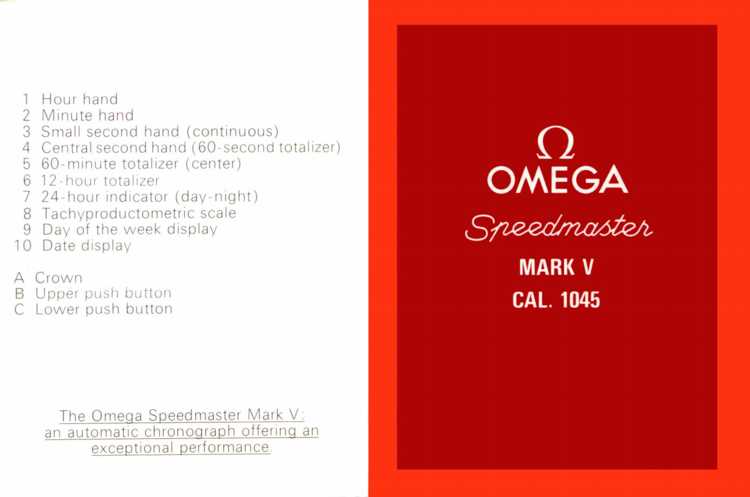 - The cover
and back panel of original manual for a Mark V c.1045
(more
on this later)...
Click on picture to enlarge in a new
window...
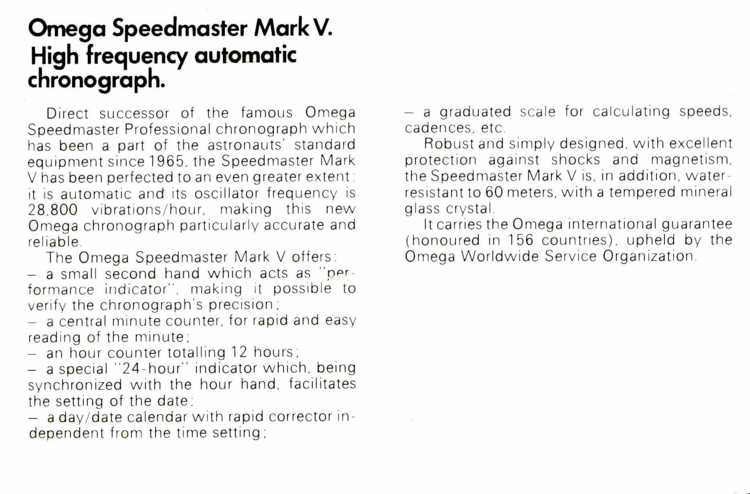 - Inside
first panel, Click on picture to enlarge in a new
window...
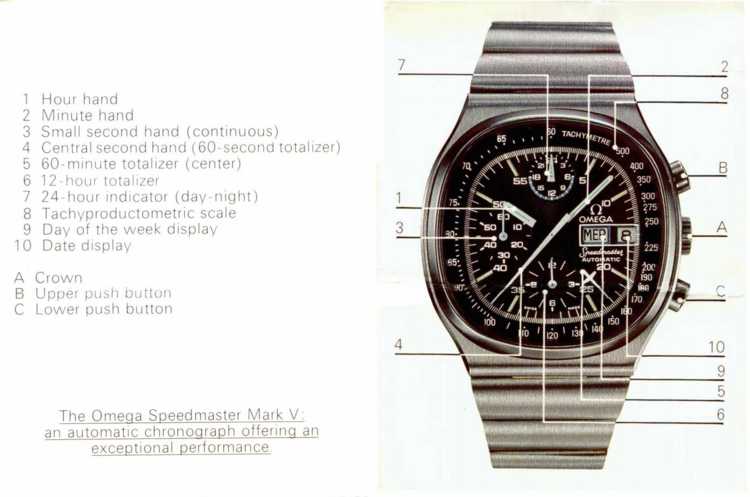 - A
composite graphic, not in the
manual, of an annotated diagram of features,
created by the author... Click on picture to enlarge in a
new window...
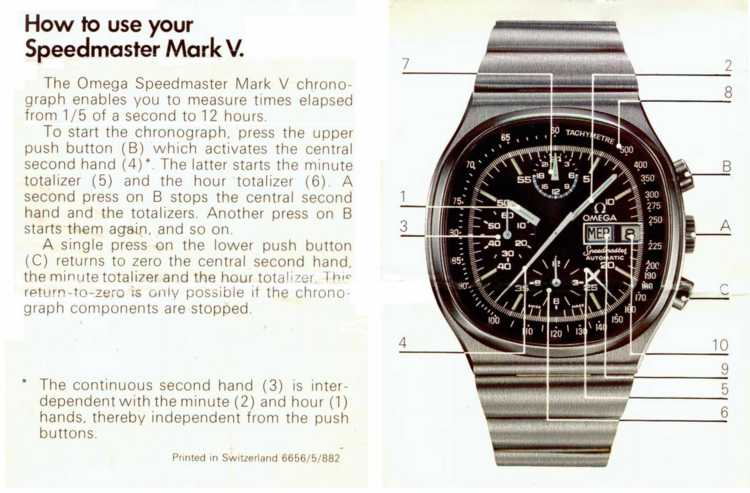 - How to
use the watch... Click on picture to enlarge in a new
window...
 - How to
set the watch... Click on picture to enlarge in a new
window...
This
particular instruction manual is an interesting document
in and of itself. By it's cover it is clearly intended as
an instruction manual for the 1984 production Speedmaster
Mark V chronograph, however it's internal photographs are
of a ST176.0017 which was produced in 1974~1977
(roughly). Here is the story on this manual as best as I
can reconstruct it without being a pest to John Diethelm
who heads up Omega's Vintage Information Department...
When Omega came out with the Mark V in 1984, they needed
an instruction manual for it, but didn't have pictures of
the final product yet. So it seems as if they used an
ST176.0017 to stand in for the ST376.0806 Mark V... An
acceptable solution since operationally the watches are
identical. Interestingly enough I have a German Language
versions of this same manual, with the same photographs,
etc. that I recieved with my Mark V (Henk recieved his
with a purchased ST176.0012)... I probably could be
persuaded to scan it in if someone were to request it,
once I relocated it in the mess that is my work area...
Another interesting point about this manual is that there
is a rather glaring
error in it that is not immediately obvious... In fact I
worked on these files several hours before noticing this
issue. I'd be real interested to see if anyone can spot
it. In fact the first person to spot it will get his or
her name included here in this document! Kjell Jorgensen
of Norway was the first person to spot that the 24-hour
indicator (pointing at 24 in the pictures) should be
pointing to either just after 10 or 22 with the main
timekeeping hands set to nearly 10:08. Sharp eyes Kjell!
Thanks for playing everyone!
-
- Thanks again to Henk van de
Weg of the Netherlands for his contribution of these
scans!
- Common
Name for
- Model:
|
|
Speedmaster
Auto Day-Date c.1045
Timeline:
|
|
|
1974
|
1975
|
1976
|
1977
|
1978
|
1979
|
1980
|
1981
|
1982
|
1983
|
1984
|
1985
|
1986
|
1987
|
|
Mark IV
case
|
|

|
|
|
TV
Dial/Link
|

|

|
|
|
TV
Dial/Bar
|

|
|
|
Tonneau/Bar
|

|
|
|
Tonneau/Link
|

|
|
|
176.0017
|

|
|
|
Mark
V
|
|
|

|
|
|
Moonwatch
Case
|
|

|
|
|
|
|
|
|
|
|
|
|
|
- The Speedmaster Day-Date
Automatic c.1045 product line consists of seven distinct
and different models with unique case reference numbers.
First introduced in 1974, shortly after the bow of the
Lemania 5100 Chronograph movement (c.1045 is Omega's term
for it's version of this movement), the first five models
introduced at that time consisted of one model, the
176.0012 with striking similarities to the Speedmaster
Mark IV Chronograph, the 176.009, using a superficially
similar but decidedly different Lemania c.1342 movement,
and four models with case shapes unique to the c.1045
series. The span of time each model was in production and
in the current/active product line in the above table is
approximate, with the exception of the Mark V and the
Moonwatch case models, which were only in active
production and in the active product line for one
year.
-
- Tale
of the Tape: Dimensions of Omega Speedmaster
Day-Date Automatic
c.1045
|
|
|
Width
|
|
|
Ref.#
|
Year
|
Calibre
|
Description
|
Height:
|
with
|
without
|
Thick-ness
|
Weight:
|
Lugs:
|
Notes:
|
- Crown
|
|
176.0012
|
1974
|
c.1045
|
Mark
IV case
|
45
mm
|
44
mm
|
42
mm
|
15
mm
|
134.05
g
|
22mm
|
Mexican Made Bracelet
|
|
176.0014(l)
|
1974
|
c.1045
|
TV
Dial/Link Bracelet
|
42.8
mm
|
42.2
mm
|
39.7
mm
|
15.8
mm
|
139.68
g
|
22mm
|
Mexican Made Bracelet
(376.0805 2nd Ref.)
|
|
176.0014(b)
|
1974
|
c.1045
|
TV
Dial/Bar Bracelet
|
43
mm
|
42
mm
|
40
mm
|
15.7
mm
|
152.6
g
|
n/a
|
2nd Case
Ref# 376.0805 (Bclt 1204/212)
|
|
176.0015
|
1974
|
c.1045
|
Tonneau
/Bar Bracelet
|
43.2
mm
|
42.0
mm
|
39.0
mm
|
15.1
mm
|
155.15
g
|
n/a
|
2nd Case
Ref#376.0804 (Bclt 1204/212)
|
|
176.0016
|
1974
|
c.1045
|
Tonneau/Link
Bracelet
|
44.1
mm
|
42.0
mm
|
39.0
mm
|
15.1
mm
|
126.67
g
|
22mm
|
Original Bracelet Made in
Mexico...
|
|
176.0017
|
1974
|
c.1045
|
Prototype
model...
|
Never entered production,
only exists in pictures...
|
|
|
376.0806
|
1984
|
c.1045
|
Mark
V
|
44.8
mm
|
45.2
mm
|
44.1
mm
|
14.2
mm
|
126.4
g
|
n/a
|
Original Bracelet Ref:
1413/019
|
|
376.0822
|
1987
|
c.1045
|
Moonwatch
Case
|
48.3
mmÝ
|
43.0
mm
|
42.1
mm
|
15.35
mm
|
118.9
g
|
20mm
|
Original Bracelet Ref:
1450/808 Ends.
|
|
|
|
Ý
This
measurement is end of lug to end of lug. Other
c.1045 cased watches have hidden or integrated
lugs...
Special
thanks to Gene Henry for providing the
dimensions of his ST 376.0822... I've since
independently measured the 376.0822 with greater
accuracy and the revised numbers are
above.
I don't
currently own a 176.0017 (yet), but I'm working
on that. In the mean time James Marcos was kind
enough to let me measure his example...
|
|
|
- The
Initial Wave
-
|
For one reason or another it seems that the
c. 1045's were not initially sold in the U.S.
market. Most of the c.1045's I see have a
non-English day wheel installed. The Mark V
appears to have only been made for Central
European consumption, and the Moonwatch c.1045
also seems to have a very small production run.
Most examples I see also come out of Central
Europe, although Janitor Jerry owned one at one
time so we can assume that they were available
in Canada at one time.
As for my examples (and the bulk of any watch
with a day complication, more below) you can
make general assumptions based on the day wheel
language:
|
French:
|
|
|
English:
|
French:
|
German:
|
Italian:
|
Portugese:
|
Spanish:
|
- Sunday
|
Dimanche
|
Sonntag
|
Domenica
|
Domingo
|
Domingo
|
- Monday
|
Lundi
|
Montag
|
Lunedì
|
Segunda-feira
|
Lunes
|
- Tuesday
|
Mardi
|
Dienstag
|
Martedì
|
Terça-feira
|
Martes
|
- Wednesday
|
Mercredi
|
Mittwoch
|
Mercoledì
|
Quarta-feira
|
Miércoles
|
- Thursday
|
Jeudi
|
Donnerstag
|
Giovedì
|
Quinta-feira
|
Jueves
|
- Friday
|
Vendredi
|
Freitag
|
Venerdì
|
Sexta-feira
|
Viernes
|
- Saturday
|
Samedi
|
Samstag
|
Sabato
|
Sábado
|
Sábado
|
|
|
Unique
Day:
|
Language:
|
|
Thu
|
English
|
|
Jeu
|
French
|
|
Don
|
German
|
|
Gio
|
Italian
|
|
Qui
|
Portugese
|
|
Jue
|
Spanish
|
|
|
These languages seem to be the most
common ones used. Typically the first
three letters are used as an
abbreviation of the date.
Thursday is the one day name and
abbreviation name which is unique in
each language. Thus to determine the
language of the day wheel cycle through
the three letter abbreviations until
you run across one of the following:
Thu, Jeu, Don, Gio, Qui, Jue...
(Note: This will work with any
Day complication watch using a 3 letter
abbreviation, not just Lemania 5100
Base, or Valjoux 7750, but also
Speedsonics, Seiko's, Citizens, and non
chronos!)... Then use the chart above
right to determine the Language of the
day wheel for the watch in question...
|
|
|
176.0012
'Mark IV-Style Case'
|
 -
     - (Mitch Noble recently had
his 176.0012 restored at Omega Bienne... This is what a
176.0012 should look
like)
|
176.0014/376.0804
'TV Dial'
|
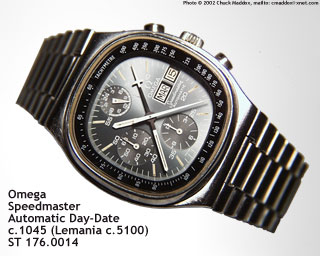
|
|
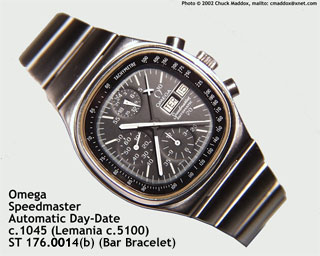
|
- ST
176.0014/376.0805 - c.1045 TV Dial/Link
Bracelet/Sunburst
Dial
- 640
x 512
version, 1280
x 1024
version
|
|
- ST
176.0014/376.0805 - c.1045 TV Dial/Bar
Bracelet/Matte Black
Dial
- 640
x 512
version, 1280
x 1024
version
|
Please note that there are two different styles of dials
on these
watches...
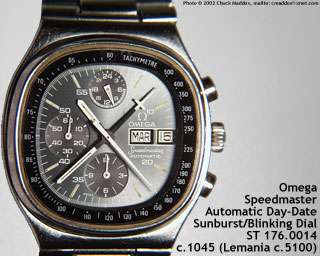
|
|
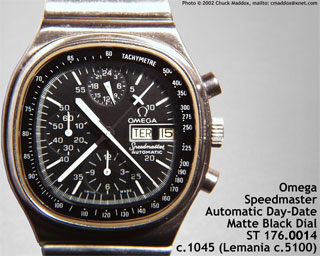
|
|
ST 176.0014/376.0805
- c.1045 TV Dial/Link Bracelet/Sunburst
Dial
|
|
ST 176.0014/376.0805
- c.1045 TV Dial/Bar Bracelet/Matte Black
Dial
|
It seems that either dial was available with either
bracelet style, please consider either to be historically
correct.
|
176.0015/176.0016
'Tonneau Case'
(376.0804
Alternate Ref #)
|
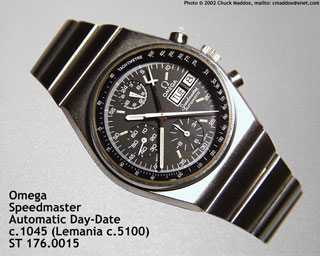
|
|
Space reserved for 176.0016
picture...
|
- ST
176.0015/376.0804
- Tonneau/Bar Bracelet/Matte Black
Dial
- 640
x 512
version, 1280
x 1024
version
|
|
- ST 176.0016
c.1045 Tonneau / Link Bracelet / Sunburst
Dial
- 640
x 512
version, 1280
x 1024
version
|
Aside from the obvious differences between the 176.0014
and 176.0017,
namely the bracelet, the dial is also significantly
different:
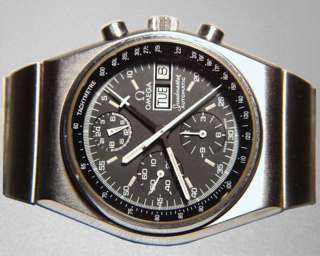
|
|
Space reserved for 176.0016
picture...
|
|
ST
176.0015/376.0804
- Tonneau/Bar Bracelet/Matte Black
Dial
|
|
ST 176.0016 - c.1045
Tonneau / Link Bracelet / Sunburst
Dial
|
-
-
- Mark
V (1984, Central European {¿German
speaking countries?} Market(s)
only):
-

|
|
Click
on photo to access a 1,280 x 1,028
Scan
|
- After producing
a slew of Mark'ed Speedmasters in the early
to mid 1970's Omega didn't produce any
additional ones for a number of years. Then
in 1984 Omega introduced the Speedmaster Mark
V, using as it's movement the familiar Omega
c.1045 movement based on the Lemania 5100
Calibre first offered in 1974. With a
diameter of 31.0mm and a 8.25mm thickness,
this 17 Jewel movement with it's 48 hour
power reserve would be, along with the
Valjoux 7750/1 and Zenith El-Primero, one of
the most popular, widely used and successful
automatic chronograph movements ever
produced.
|

|
- The
Speedmaster Mark V as
clearly indicated on the
dial.
- All
other models using this
case are variants,
not Mark
V's.
-
|
|
According
to most literature the Mark V was
only sold in the West German market.
However, Daniel Klooz emailed me
that it was also marketed in
Switzerland, where he bought his
Mark V in 1986. Which he paid 600
Swiss Francs (Regular Price was 1200
Swiss Francs). He mentions that his
is a very accurate and dependable
watch and remains in his
collection...
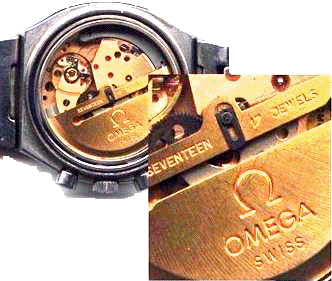
|
--
c.1045 movement in a
ST176.0014 (1974)
|
|
- The Mark V
consisted of a c.1045 movement that had not
been used in a Omega for a number of years,
incorporated in a modified case that had been
used previously in the Speedmaster 1982 c.861
model. Both of these models were marketed
only in central Europe, possibly German
speaking countries only, for a short amount
of time, usually quoted as only one year in
each instance. While the Time Capsule Book
states it was marked only in Germany I find
it difficult to believe that it was available
in the DDR (East Germany) as I think it
unlikely that many East Germans bought or had
access to this model considering the
condition of the DDR's economy at that
time... It was however apparently available
for purchase in Switzerland, and it is not
too much of an intuitive leap to assume it
was also probably available in Austria.
-
- Mark
V Cased c.861 Variants:
-
- In addition to
the Mark V Speedmaster Omega also produced at
least four variants of this case with the
c.861 movement.
- Satin finished
stainless steel case/bezel with black
dial.
- Satin finished
stainless steel case/bezel with satin silver
dial.
- Satin finished
stainless steel and gold case/bezel with
black dial.
- Satin finished
stainless steel and gold case/bezel with Gold
Dial and Silver sub-dial's.
- Mark
V Cased c.861 Variant
Showcase:
|

|
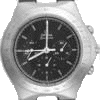
|

|

|

|
|
c.861
in a Mark V
|
1)
SS/Black Dial
|
2)
SS/Silver Dial
|
3)
TT/Black Dial
|
4)
TT/TT Dial
|
- The Time
Capsule book lists these c.861 variants as
being offered only in Germany for the year
1982. So in all actuality the Mark V is based
on these earlier models. However... It
should be noted that the only "true"
Speedmaster Mark V is the one with the
c.1045, as it is indicated as such on
it's dial... The other models are simply 1982
Omega Speedmaster's. The Time Capsule book
lists the Reference number of only the
SS/Silver Dialed version (Number 2 above) as
ST145.0040. The Reference numbers of the
other variants are currently unknown.
However, I soon expect to know the Reference
number's of Number's 1 and 4 above soon as I
have located examples of each and have
purchased them. I remain searching for an
example of the others.
-
- Commentary
on the Mark V and it's c.861 variants:
-
- Finally! I
have acquired a Speedmaster Mark V, to go
along with my two examples of the c.861
variants (1 and 4 above). Both the Mark V
case with the c.861 movement and the Mark V
case to be the nicest, best engineered and
most modern of the Mark Series cases. The
"c.861 variant" case is actually subtly
different in design and size than the case
used in the Mark V Speedmaster. The case is
thinner and has a couple of other minor
differences due to the differing dimensions
between the c.861 and the c.1045 movements.
As a result the Mark V's case thickness at
14mm is 1.5mm thicker than the c.861
Speedmasters using this basic case design.
-
- In a way
it is also a misnomer to say that
the c.861's are Mark V variants,
as they were produced prior to the Mark V. In
reality the Mark V is a variant of the
c.861's not the other way around. However,
since the c.861's were never given a
distinctive name it is easier to refer to
them as Mark V variants than the other,
proper, way...
- If Omega
were ever to consider offering for sale a
"Modernized" Speedmaster with the c.861 the
Mark V case would be a perfect starting
point. It is sleek, modern, smart looking,
comfortable, offers great protection for the
crown and buttons. I'd probably recommend a
inverse treatment (black background with
metallic numerals) on the Tachy ring for
viewability, but it's a great watch from a
wearer's standpoint.
-
- Note:
Since the initial publication of this article
I have written a
separate article with more details on the
German Market Speedmasters called "Hooked
on Teutonics".
For more information and scans please
link
over to that article.
|
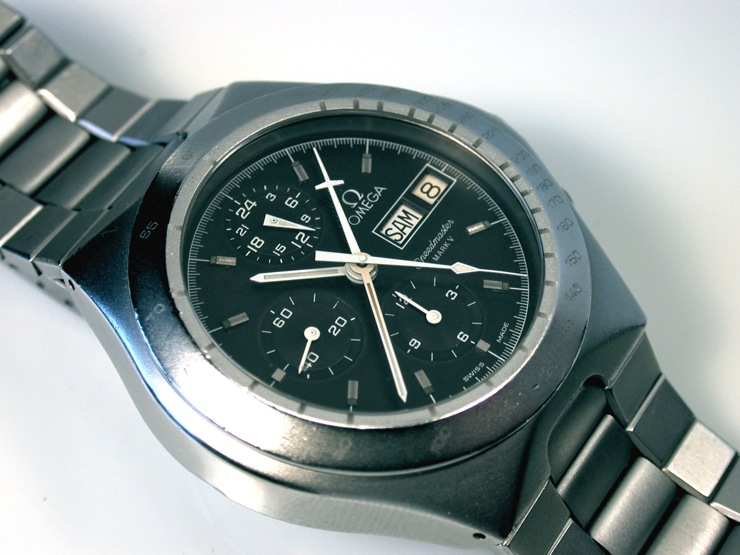
-

|
|
Click
on photo to access a 1,280 x 1,028
Scan
|
- 376.0822
Moonwatch case
For the final
(unfortunately) installment in the Omega experience with
the Lemania movement, Omega decided to produce a model of
the c.1045 line which is probably the model they should
have produced in the first place. Choosing the Moonwatch
case as it's inspiration, only offered in 1987, the
376.0822 nearly certainly had a production run
(unnumbered) of under 2,000, probably under 1,600,
possibly 1,300 or even fewer [¿1,000?]. The
376.0822 was the first Automatic movement offered in a
full-sized (about 1mm thicker) moonwatch case, first time
Omega offered Day-Date on a Speedmaster, a watch that is
nearly as easy to read as a moonwatch under duress and it
has a lot more things going on the dial than a
moonwatch.
-
- It's also a watch which has
become known among collectors as "The Grail". Why? It's a
long story...
A personal admission: I'm the one to blame for "the
Grail Watch" moniker...
My first Vintage Omega eBay purchase was nearly a
376.0822 out of Germany in January of 1999. Because the
376.0822 was in Germany, I didn't know any German (hell
anyone in Germany at the time), I went instead for a 176.012
(the most common of the 7-8 Speedmaster c.1045 variants
which sports a Mark II/IV style case) out of Iowa for around
the same money (about $600 USD). I had owned my Mark II for
15 years at this point, that style case was a known quantity
to me, and if I had a problem with the watch I figured I
could gas up my Explorer and drive out to Iowa if need be, I
couldn't really do that with the German watch.
About a month later I realized I wish I had bought both
examples... So I stared looking for another example to
purchase. And I searched, and searched, and searched. The
only one I found was listed at over $10,000 on a Japanese
website and there wasn't a speck of English on that site
aside from "Omega Speedmaster" and Arabic numbers. It took
me a year and a half to find another one (aside from the
Japanese origin one) offered for sale and it was on eBay out
of Philadelphia. I got into a three way shootout for it with
a fellow TZOFer and one of the well healed Japanese
collectors and came out in 3rd place with an winning bid
well north of $2,700 (this is summer 2001). I finally
tracked one down about six to eight months later with the
help of another TZOFer and brought home my example. During
this quest I searched with the intensity that King Arthur
searched for the Holy Grail and I began calling this model
"the Grail" because I was that obsessed with it.
I also had a long struggle to find the Gray dial Teutonic
(Germanic market) Speedmaster c.861 and I call this model
"Moby" as a reference to Ahab's obsession for the Great Gray
(dial) Whale (Speedmaster). Some of my watches have
nicknames. Some of them stick and become the commonly used
names for that watch. Ever hear of the "Darth Vader
Seamaster"? No one ever called it that before I did, and the
watch was discontinued 2-4 years prior to Star Wars. But if
you say "Darth Vader Seamaster" to a watch collector and
s/he'll know exactly what you are talking about...
I know at least a half a dozen collectors who now own the
Grail who can tell similar tales of the hunt, the near
miss(es), the disappointment, the despair and the final joy
of getting one. Hence, "the Grail"!
As for the 376.0822 (Grail) itself...
- It is considered one of the rarest of the c.1045
Speedmasters (only the Mark V comes close to the Grail's
rarity).
- It is the first time Omega offered a Moonwatch case
styled Speedmaster with:
- an Automatic Movement
- Day
- Date in a window aperture (the 345.0809 had a date
pointer)
- 24-hour indication
- It also utilizes the 1450 bracelet, which was by far
the best bracelet Omega had used with the Speedmaster up
until that time and is highly coveted by collectors
- It sports the most easily readable dial of the c.1045
Speedmasters. (frankly, the other c.1045's dial
readability isn't even in the same league as the Grail.
I've had owners of other c.1045 Speedmasters scoff at
this assertion until I pull out my 376.0822 and bit
tongues and cheeks rapidly occur)
For these reasons it is in very high demand by collectors
and avidly sought when offered. I have my example which is
mid-90's or higher in terms of condition, and I'd love to
have another example at a somewhat lower price. Who knows...
In a year or two when I've revamped my desktop computer
setup and done the new car thing I might be in the market
again.
I (and other owners) believe that were NASA to conduct a
Chronograph contest like the one's that resulted in the
adoption of the moonwatch the watch most likely to topple
the moonwatch would be the Grail. Unfortunately that won't
happen because Swatch/Lemania has stopped production of the
c.1045.
The sad fact is that if Omega had started with this model
of the c.1045 first and produced it in quantity, it's not a
stretch of the imagination at all to think that this model
would still be in production, be in demand among customers
to the extent it might even rival the popularity of the
moonwatch. As it is, sadly, Omega stopped it's usage of the
c.1045s after producing far too few examples of this model.
Swatch Group recently purchased Lemania Watch company,
promptly renamed it "Montrose Bregruet" and ceased
production of the Lemania 5100 movement. The sad end of the
c.1045 Speedmasters has an even sadder ending with the end
of Lemania 5100 production.
As a result of the virtues of this model, the low
production run and the high interest among collectors, this
model of the c.1045's outstrips all of the other models in
market value. This model routinely fetches prices greater
than $4,000 when offered for sale and has even approached
selling prices in near and above $5,000. I've archived
several recent auctions in this folder on my webspace.
If you see one of these and you think you might be
interested, be ready and have your monetary ducks in a row.
If you're not in the market, watch anyway. Nearly everytime
there will be lots of fireworks at the end of the auction
gunfight. It can truely be a spectacle to watch!
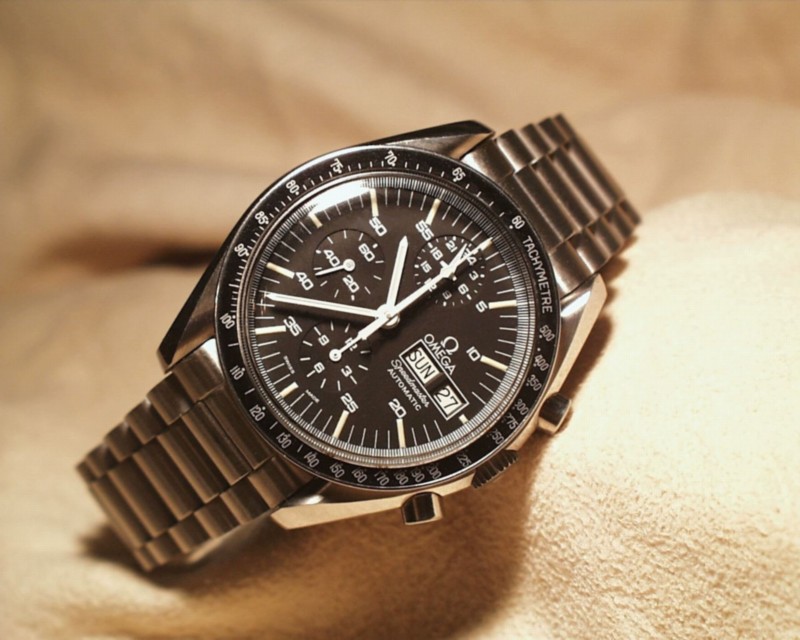
|
-
Rough
Price Ranges (Circa 2003):
-
- For me to authoratively
state values of any of these watches would be quite
arrogant of me, for I am by no means an expert. The best
I can do is to state general ranges that I have seen
these models go for. I've seen the Mark II cased Ref.
176.0012 (Fig. 1) version typically go in the
$500-800 range, the rounded-corner square dial Ref.
176.0014 (Fig. 2) version typically go in
the $700-850 range, the Tonneau cased 176.0016 (Fig.
3) version typically going in the $750-950 range, the
other models I haven't seen enough offered for sale to
even guess at a range. However, you should be aware that
these ranges vary greatly depending on the condition of
the watch, quality of the bracelet, and the demand for
the particular watch. According to the dealer that I
bought my 176.0014 from he had offered it two or three
times on TZ's Sales Corner before posting it on that
auction site where I snapped it up as it was the cleanest
one I have seen. I had missed it's posting on the Sales
Corner. It is also important to note that people have
preference for or against certain models or styles of
watches. Some people simply do not like the looks of
style X while other's will think it's the bee's knees.
Personally, I feel that the Tonneau cased c.1045 (Fig.
3) is about the most handsome chronograph that Omega
has ever made. Your mileage will vary.
-
Tonneau
Cased c.1045 Variants:
-
- One of the nice things
about posting an article such as this is that people will
ask you questions. Some of which will exceed your
existing knowledge of the subject and requires you to do
further research in order to answer. Sumihisa Furufuji is
a gentleman from Japan who enlisted my assistance in
locating a Tonneau cased c.1045 for purchase. I was
fortunate that I was able to locate one for Sumi. But in
while in the process, Sumihisa asked me the
following:
-
|
- " I have a
question about Ref.176.0016 case. I think
there are two types.
- Please check
enclosed picture. "
|
|
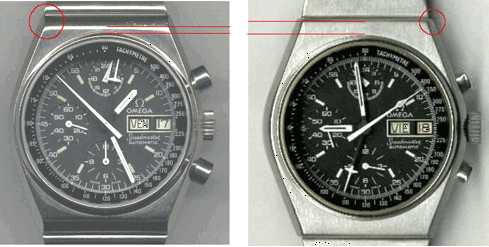
|
|
|
"Left
side type has narrow distance from
corner."
|
|
"Right
side type has wide distance from
corner."
|
|
|
- "Bar"-Style
bracelet Tonneau
c.1045
- ST176.015
|
|
- "Link"-Bracelet
Tonneau c.1045
- ST176.016
|
|
|
Photo's
and visual aids courtesy of Sumihisa
Furufuji
|
- Yes, there are two
different type of cases... I have an example of
each...
-
- One is slightly shorter in
length and is the one that has the "Bar"-Style bracelet.
Which is the one's pictured on the left in Sumi's
(fantastic) graphic. The other one (the longer length
one) has a longer case length to allow it to accept a
22mm strap or a bracelet. It needs the extra length to
allow clearance for the bracelet/strap and spring bar.
Because the Bar-Style Bracelet is of an integrated design
it can and does use a shorter
case. Here
are the measurements that I have taken from my example of
each of these watches:
-
|
Dimensions
of Tonneau-Cased c.1045's
|
|
Reference
|
Description
|
Height
|
Width
|
Thickness
|
Weight
|
|
w/Crown
|
w/o
Crown
|
|
176.0015
|
Tonneau / Bar
Bracelet
|
43.2
mm
|
42.0
mm
|
39.0
mm
|
15.1
mm
|
155.15
g
|
|
176.0016
|
Tonneau / Link
Bracelet
|
44.1
mm
|
42.0
mm
|
39.0
mm
|
15.1
mm
|
126.67
g
|
- As you can see the
dimensions are exceedingly similar. Most of the
differences are in the weight and the height. Most of the
weight difference can be attributed to the HEAVY
Bar-Bracelet, the height difference is due the the
necessary provisions to accomodate the spring-bars that
are necessary for attaching a strap or bracelet to the
watch's case... I also should note that the ST176.0014 TV
Dial (or rounded corner square-dial) c.1045 also comes in
both a Link and bar bracelet variants. As I've never
handled the bar bracelet version I do not know the weight
or case reference number. If you own one of these and can
provide me information please
contact me...
-
- -- Special thanks to
Sumihisa Furufuji for his photos and valuable assistance
with this section!
-
-
Omega
c.1045 Part's lists...
-
- A 176.0016 owner Alain
LeFaucheux was kind enough to send to me some materials
he came across while performing a restoration on his
c.1045:
-
- One get's an enhanced
appreciation of the complexity of the c.1045 chronograph
by looking at the part's list. Special thanks to Alain
for his valuable contribution to this article. I should
add that I have huge full-resolution versions of these
three files which self-extracting zip format weigh in at
over 2.2 megabytes. I would be happy to email them upon
request.
-
- Matthias
Liebe-Kleymann (with whom, I co-wrote an article on
Heuer
Carrera Chronographs)
was kind enough to purchase and share with me photocopies
of an
Omega c.1045 Service Manual in
German. Which I have
split out into a
separate article.
-
-
An
Interesting Speedmaster c.1045...
One of the things that makes
watch collecting so interesting is just about the time
you've seen everything and have a decent handle on a
particular topic something comes along and gives your
existing knowledge base a nudge.
Then comes along something that
I hadn't actually seen before... (Thanks to Spudmax for
bringing this to my attention):
 
A little mystery here, eh? It
looks to be a 176.0012 but with lugs, and the watch also has
a standard 176.0012 case...
Here is the description
translated from the original language into English via
AltaVista Bablefish:
Omega speed master automatic
chronograph, 70's. Caliber omega 1045, red-gilds. Light
customs tracks, two thin scratches on the glass. All
functions perfectly. Goes very exactly. The chronograph is
supplied with two housing versions, which one changes
through the clock container exchange can. See pictures. The
hidden lug version with steel strip is the original version.
The second housing version was manufactured by me in manual
work, and is particularly suitable to carry this otherwise
very heavy chronograph with leather bracelet even to more
elegant events. The clock container is held in the
respective housing version by an O-ring, which presses with
into a groove locked. If you have interest in a unique and
unusual watch, then this is the opportunity. Original omega
steel strip and high-quality new leather bracelet (see
photos) is contained in the scope of supply. Good Luck
success and have fun bidding!
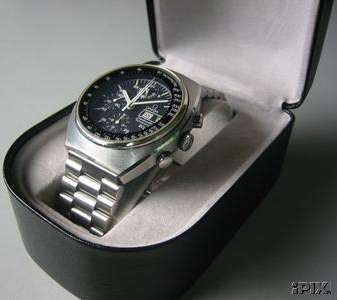 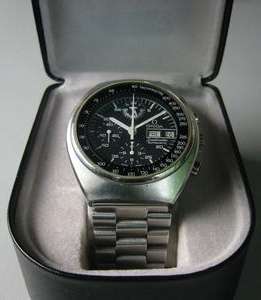
Ah, the description clears
everything up... So what we have here is a genuine 176.0012
c.1045 Speedmaster Automatic with an additional custom made
(non-Omega) lugged case in addition to the case that Omega
shipped with this particular watch .
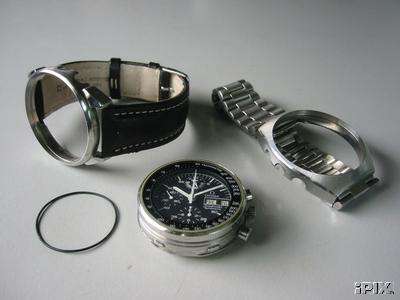
- All in all a very
interesting piece even though the argument could be made
that it's originality is, well, quite unusual... I've
since had several email conversations with the creator of
this custom c.1045, a friendly fellow named
Gilliam.
If you have a spare case you'd like modified, or even a
176.0012 that you'd like converted, please feel free to
contact
him... Gilliam
recently sent me some more pictures to share in this
article:
-






 - In
order to keep download times low, I've included these
thumbnail pictures, click on them to see the
originals.
-
Summary:
-
- The Speedmaster Automatic
Chronographs are among the most sophisticated
chronographs Omega has ever produced. About the only more
complex chrono's Omega makes are moonphase and
triple-date variants of the Speedmaster.
I wish I had more information
that wasn't conjecture and wished that I was able to piece
together more, but what can you do? If anyone has more
information to add please post it here or email me at the
link above.
As an aside, the response to
this article has been both gratifing and overwhelming! I
have had people contact me from many different nations from
Japan to Spain and other locations elsewhere in the world. I
have also tried to find suitable examples of specific models
for people who have either became interested in a specific
model because of this article or had been searching for
information on these watches and found the article either
through trying or by luck.
-- Chuck
Statement
of rights retained and permissions granted...
Permission is granted for
Damon,RJ, Derek, Ross and/or Frank N. to include within the
FAQ's they are writing as long as I'm given credit for this
work (and Gerry L. is given credit for the picture of his
Ref. 376.0822 Speedmaster). Permission for personal,
educational or non-commercial use is granted. The author
retains all other rights not specifically mentioned
here...
For all other use please contact
the author.
Disclaimer: Opinions are my own
and knowing me should be taken with a grain or two of
salt...

|
--
c.1045 movement in a ST176.0014
(1974)
|
|






























